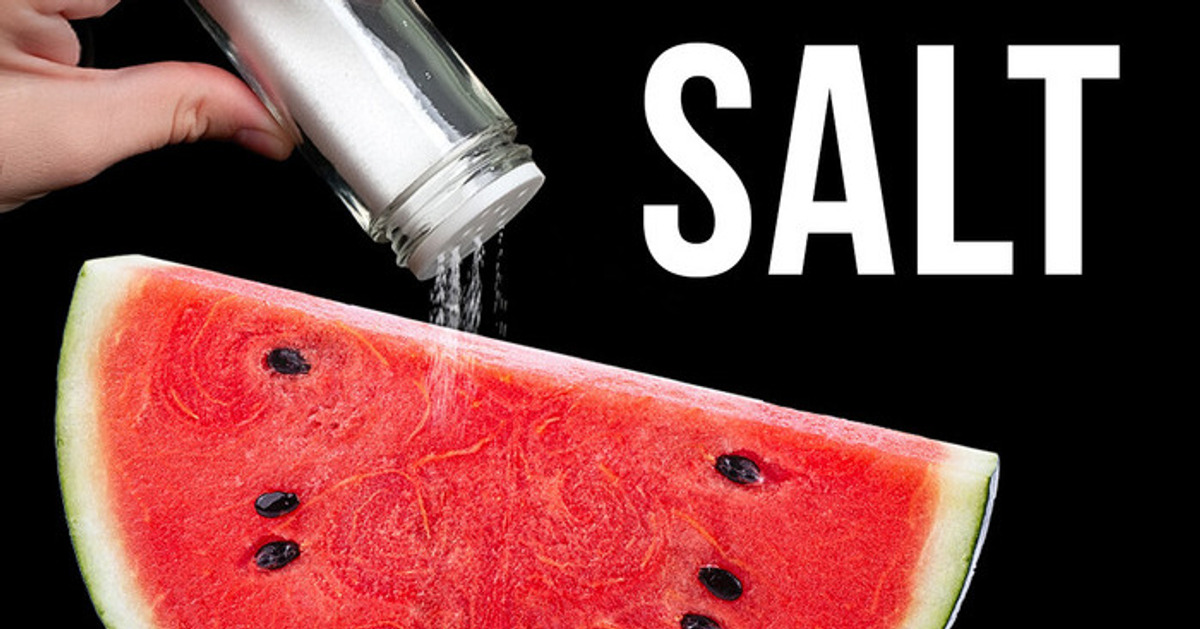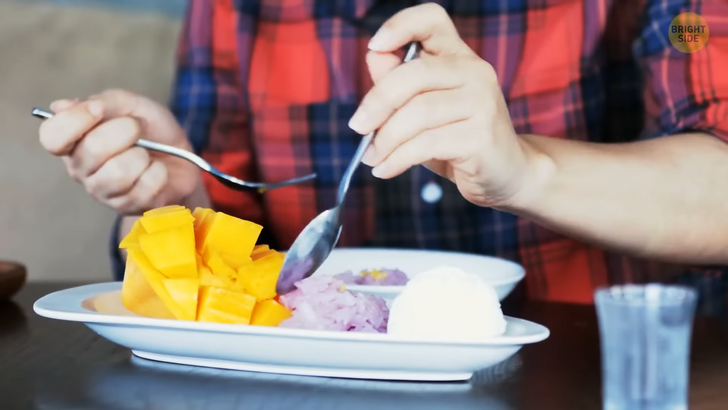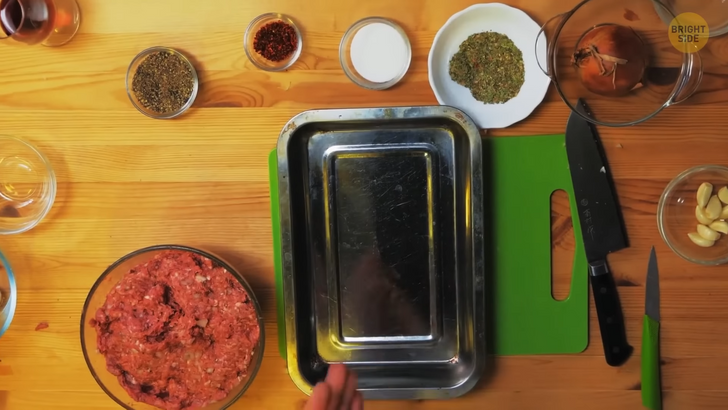12 Stepparents Who Cracked the Code to Their Stepchildren’s Hearts


You’re watching your favorite cooking show when suddenly, the star chef adds a pinch of salt to some jam that is supposed to go in a dessert. You pick up the phone to call and complain, but right then the chef explains. It turns out that adding salt to fruit is a common thing in different cuisines across the world. In Mexico, they like to spice up mango and citrus fruits with salt and chili powder. You can try mango with a shrimp taste in the Philippines and salted watermelon in the Southern states.

So, how does it work? Let’s say you’re eating a raw mango sprinkled with salt. With the first bite, you notice the salty flavor, and the sweet fruity taste is then slightly delayed. It feels as juicy and amazing as ever. It’s most likely because salt affects the sweet taste receptor for sugar, and then really magic happens on a molecular level. One study even found that we have more sugar detectors in our taste cells than scientists previously thought. One of those detectors must direct sugar to a sweet-taste cell when it gets in contact with salt.
You can try and put salt on any fruit you like, but the effect will be different. Salt can make sweeter fruits like cherries and strawberries even sweeter and balance the flavor of grapefruit, pineapple, and watermelon. Just take a ripe fruit and slice it the regular way and sprinkle the pieces with salt. Large flaked sea salt might taste more intense, plus it looks more beautiful. After 10 minutes, your gourmet dessert will be ready.
So, you need to chop up a heap of iceberg lettuce, but that tough core in the middle doesn’t want to leave. Just hold the lettuce head in both hands with the core end down and slam it against a cutting board or some other solid surface. Not your brother. Now you should be able to pull the core right out of the bottom and slice the rest of the lettuce without a problem.

The next time you take the butter out of the fridge and struggle to spread it because, you know, it’s hard as a rock, reach for your grater. With its help, you’ll easily flake off tiny pieces of butter that will melt instantly on a warm toast. You can also spread them much easier on cold bread without putting your sandwich in the microwave or waiting for a while to soften the butter. Professional bakers approve of this tip and have been using it for a long time.
When you’re frying something, you first heat the pan and then put the food on it, right? Well, this logic won’t work if you want to make your bacon crispy. On a hot pan, the meat will cook before the fat can melt out of it. Your bacon will be too fatty and rubbery. So, you gotta lay the strips on a cold pan and then turn on medium-low heat. The fat will render out of the meat, and the final result will be super yummy and crispy.
Have you ever tried boiling pasta in a frying pan? I know it sounds a bit weird, but it can actually help you save a lot of time, water, and energy. Instead of filling a huge pot with water and waiting for it to boil, put your pasta in a frying pan and cover it with cold water and add some salt to it. Your pasta will be cooking while the water is getting to the boiling point, so it will be ready much faster than normal. And that water left in the pan will make an excellent base for a sauce because it’s filled with starch. Mix it with pesto, tomato sauce, and garlic butter — mmmmm, it tastes like it’s straight out of a gourmet restaurant.

The secret to cooking the most delicious and fluffy mashed potatoes is to dry them before you mash them. After boiling, you can either put them in a pot and leave them over low heat on the stovetop or keep them on a baking sheet in a low oven. Then, add melted butter that will coat the starch in the potatoes, and only then slowly add milk. Now your mashed potatoes will have the best possible structure and flavor.
If you’ve shed enough tears over onions when trying to slice them, this one is a must-try for you. Peel the onions, cut them in half, and leave them in a fridge in a bowl of iced water for half an hour before you start cooking. The reason behind your tears is the sulfur that onions take from the soil while growing up. When you damage its cells, the acids contact the enzymes that start a whole bunch of reactions and release a chemical that makes your eyes water. Freezing the onion can weaken that chemical. To minimize it even more, only use a sharp knife to slice onions. This way, you’ll do less damage to its cells.
It’s much easier to peel an avocado if you freeze it first. Just put it in the fridge as it is, give it some time, then take it out and hold it under warm running water. Now you can peel it easily after you make a couple of criss-cross incisions.

The best way to keep herbs fresh and juicy is to store them like flowers. If you don’t have the right size vase, take a Mason jar or a water glass and fill it with an inch of water. Now put the herbs inside as you would do to your roses. For parsley and cilantro, cover the jar with a plastic bag and store the bouquet in the fridge. Basil loves sunlight, so you’d better leave it uncovered on the counter.
If you’ve made too much sauce or have some leftovers in a can that doesn’t seem to be enough for anything, you can save it from the trash can. Pour the sauce into an ice cube tray and keep it in the freezer. Now if you need to spice up a meal, you can always add a couple of sauce cubes to it. Plus, as a bonus (which is redundant), the sauce will last longer this way than it would in the fridge.
Do your meatballs always turn out to be perfectly the same shape and size? Then just skip this one. But if you’re more like me, just use an ice cream scoop to get the right amount of your minced meat mix. Try saying that five times. The balls will be the ideal shape, and your fingers won’t get sticky.

The easiest and probably the most beautiful way to slice a mango is to turn it into a “Hedgehog.” Wash the mango under running water. Don’t squeeze it while doing it. Now, put it straight up on a cutting board and cut it into 3 pieces from the top downwards. Just leave that flat pit in the middle piece, there isn’t much you can do with it anyway. Now your mango will have two cute cheeks.
I mean, its fattest parts. Next, make crosswise and lengthwise cuts in the mango cheeks. Leave some even distance between the incisions, and don’t go all the way through the skin. Now press on the back side of the mango until the flesh pokes out. Does it look like something to you? Yep, a hedgehog, hence the name of this slicing method. The final step will be to slice off the mango cubes into a bowl. Then eat.

This one has all the potential to become your new breakfast favorite: you can cook an omelet in a mug! Take a large microwave-safe mug and coat the inside of it with olive oil or spray it with cooking spray. Add two eggs and 1 tablespoon of milk and mix them with a fork. Now add salt and pepper and any cheese, veggies, and herbs you like. Put it in the microwave on high for 30 seconds. Take it out, stir it with a fork, and then put it back in for another 30 seconds. And voila, your breakfast is served! Be sure to use another mug for your coffee, otherwise you get eggs in your coffee, and nobody has a recipe for that.











